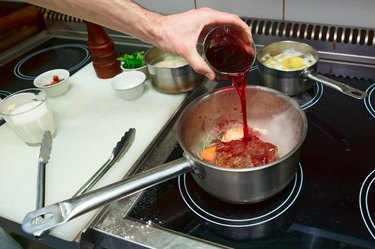
Wine is a coveted cooking ingredient because it intensifies the flavors of the dish, which is why it's often used in sauces, stews and marinades, as a basting liquid and to deglaze a pan. But can children or babies eat food cooked with wine?
Well, it depends: With appropriate cooking methods, foods made with wine can be safe for kids. But with the wrong preparation, alcohol can remain.
Video of the Day
Video of the Day
Here's how to cook wine safely for kids, including how to best evaporate alcohol from your meals.
Tip
Cooking can eliminate the alcohol content from wine to non-alcoholic levels.
But the amount of alcohol that evaporates depends on the cooking method and preparation — that is, some dishes cooked with wine will have a higher alcohol content than others. Plus, the dish will likely still include the wine's flavor, which may be a drawback for some parents.
Make a decision about whether or not to allow your kids to eat food cooked with wine based on the dish's preparation and your personal stance on children tasting wine's flavor
Does Alcohol Cook Out of Wine?
Cooking wine can help burn off some of the alcohol content — provided you're preparing the dish at or above the boiling point of alcohol, which is 173 degrees Fahrenheit, per Idaho State University (ISU).
But exactly how much alcohol evaporates depends on how you cook it, per the U.S. Department of Agriculture (USDA). Here's how much alcohol is removed from food based on preparation method:
Alcohol Burn-Off Chart
Preparation Method | Percent of Alcohol Remaining |
|---|---|
Stirred into hot liquid and removed from heat | 85% |
Flambéed | 75% |
No heat, stored overnight | 70% |
Baked for 25 minutes without being stirred into the mixture | 45% |
Stirred into mixture and baked or simmered for 15 minutes | 40% |
Stirred into mixture and baked or simmered for 30 minutes | 35% |
Stirred into mixture and baked or simmered for 1 hour | 25% |
Stirred into mixture and baked or simmered for 1 1/2 hours | 20% |
Stirred into mixture and baked or simmered for 2 hours | 10% |
Stirred into mixture and baked or simmered for 2 1/2 hours | 5% |
While this information is from 2007, it's still widely used as a resource when it comes to cooking with alcohol.
Note: An alcohol content of 5 percent or lower is considered non-alcoholic, per the FDA. Some products that you'd likely think of as alcohol-free — such as fruit juices or soft drinks — may actually contain small amounts of alcohol, according to the FDA, but would still be considered non-alcoholic.
Should You Cook With Wine for Kids?
If you're deciding whether or not to include cooking wine (or other alcohol) in a meal your kids will eat, first consider how you're going to prepare the food based on the table above.
Per the USDA, you have to cook, simmer or boil a dish that contains wine for more than 2 1/2 hours to remove the alcohol. Accordingly, if you must prepare a dish with wine, only give it to your kids if it's been cooked longer than that so the alcohol evaporates. Use extra caution with younger children, toddlers and infants.
On the flip side, any recipes that call for adding wine without heating it are not suitable for children. Meals that include a large volume of wine or have a relatively short cooking time after adding wine are also inappropriate given the amount of alcohol that will remain — for instance, this is the case for fruit macerated in wine or flambéed desserts like bananas foster.
Can Toddlers Eat Food Cooked in Beer?
Similar rules apply to foods cooked in beer, per ISU: The longer you cook dishes at or above the boiling point of alcohol, the less alcohol will remain.
In other words, a meal with beer added after much of the cooking process is over won't be safe for kids, whereas a stew cooked for many hours will contain significantly less alcohol.
Tips for How to Evaporate Alcohol
Besides your cooking method, there are some other tips that may help you remove alcohol from your meals.
1. Use a Wide Pan
Cook with a wide, uncovered pan, which gives the mixture a larger surface area that better allows the alcohol to evaporate, per ISU.
2. Stir Often
Stirring your culinary concoction frequently may also help reduce its alcohol content by encouraging more evaporation, according to ISU.
3. Try Substitutes
Sometimes the best way to ensure there's no alcohol in your dish is to not use it in the first place. Fortunately, there are several cooking wine substitutes you can use instead.
Swap red wine for grape or cranberry juice, and white wine for apple or white grape juice, per the University of Nebraska-Lincoln Institute of Agriculture and Natural Resources. You can also replace wine with vinegar, lemon juice, stock or water with herbs.
Is Cooking Wine Safe to Drink?
Though you can technically drink cooking wine if you're an adult, it's not intended to be used as a beverage, according to the University of Washington. Cooking wine is alcoholic, so it (or any wine, for that matter) is not good for kids who are under the legal drinking age. That is, if you — or children — consume cooking wine, you can get intoxicated.
- U.S. Department of Agriculture: "USDA Table of Nutrient Retention Factors, Release 6"
- University of Nebraska-Lincoln Institute of Agriculture and Natural Resources: "Basic Ingredient Substitutions"
- Idaho State University: "No Worries, the Alcohol Burns Off During Cooking—But, Does It Really?"
- University of Washington: "Safer-use Strategies: Alcohol"
- FDA: "CPG Sec 510.400 Dealcoholized Wine and Malt Beverages - Labeling"